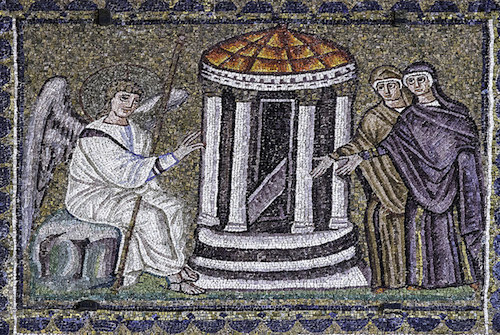We run our website the way we wished the whole internet worked: we provide high quality original content with no ads. We are funded solely by your direct support. Please consider supporting this project.

What the Resurrection Says About the Cross
As with every other aspect of Jesus’ life and ministry, even the resurrection must be understood in light of the cross. This event was not just the resuscitation of a random corpse. It was the resurrection of the Incarnate Son of God who had fulfilled the human side of the God-human covenant by living a sinless life and who, as an unsurpassable expression of divine love, came to earth and entered into the worst of human evil and carried it all on his shoulders. Understood as such, the resurrection can only be viewed as God’s vindication of the self-sacrificial life and death of this God-man through whom God’s eternal character was made known.
For this reason the resurrection must not be interpreted as a display of triumphalist power that contrasts with the humble, cruciform, character of God revealed on the cross as well as throughout Jesus’ ministry. It was rather a display of power that confirmed that the cross is in fact the revelation of God’s true character and that God’s enemy-loving, non-violent, self-sacrificial way of responding to evil is in fact victorious.
It is for this reason that the One who sits on the throne in the Book of Revelation and who alone is worthy to open the scroll of God’s plan for history is the victorious lamb who was “slaughtered” (Rev. 4-5; 21:22; 22:1,4). And it’s for this reason that those who conquer are depicted as doing so because they “follow the Lamb wherever he goes” (Rev. 14:4), bearing witness to his victory and imitating his sacrificial death (Rev. 12:11). Moreover, throughout Revelation we find the emphatic declaration that the glorified and victorious Jesus is the same as the crucified Jesus (see Rev. 5:6, 9, 12; 7:14, 17; 12:11; 13:8; 17:14).
This is precisely why all who have been raised with Christ and who therefore participate in his resurrected life (Rom. 6) reflect their participation by taking on a cruciform character that leads them to sacrificially serve others, including their enemies, just as Jesus did (Rom. 12:7-12). The same point is made by noting that for Paul, the Spirit that dwells within believers is the Spirit of the crucified Christ that empowers them to live according to “the law of Christ” (Gal 6:2), which is to love others as he loved us “when he gave his life for [us]” (Eph. 5:1-2).
Ernst Käsemann is thus surely on the mark when he holds that the cross is “the signature of the one who is risen.”[1] And the surest signature that anyone belongs to him is that they participate in Christ’s risen life, which means they participate in the expression of his self-sacrificial love.
[1] E. Käsemann, “The Saving Significance of the Death of Jesus in Paul,” in Perspectives on Paul, trans. M. Kohl (Philadelphia: Fortress, 1977), 56.
Related Reading

What About the Harsh Words of Paul? A Response to Paul Copan (#4)
This post is my fourth response to a talk given by Paul Copan at the Evangelical Theological Society in November in which he raised a number of objections to Crucifixion of the Warrior God. A major part of Copan’s critique centered on my claim that the love of God that is revealed on the cross,…

What Jesus Revealed About Being Human
According to the creation story, when Adam and Eve ate the fruit, they essentially ceased being the wonderful, God-centered, God-dependent human beings the Creator intended them to be. They became less than fully human. Instead, they began using everything and everyone in the world as surrogate gods, trying to get from people, deeds, and things…

Tribalism
Sandra Unger spoke for Greg while he was on vacation the week after the 4th. In this clip, Sandra explains whats tribes are and how that creates unintended separation between people. In the full sermon, she speaks about what it means to be part of the Jesus Tribe. She discusses the reasons people are prone to…

The Revelation of God in the Cross
The cross cannot be understood apart from the resurrection, just as the resurrection can never be understood apart from the cross. They are two sides of the same coin. If you consider the cross apart from the resurrection, then the crucified Christ becomes nothing more than one of the many thousands of people who were…

The Cross is Revelation and Salvation
The way Christ saved us from the curse of the law was “by becoming a curse for us” (Gal. 3:13). So too, the way Christ freed us from the condemnation of sin and enabled us to “become the righteousness of God” was by becoming sin for us (2 Cor. 5:21). Getting this point is crucial…

Lighten Up: Listening for the Voice of the Father
Christian comedian Michael Jr. posted this video last week for Father’s Day. What it says about love and connection and God in just a few minutes is so lovely. Enjoy.
